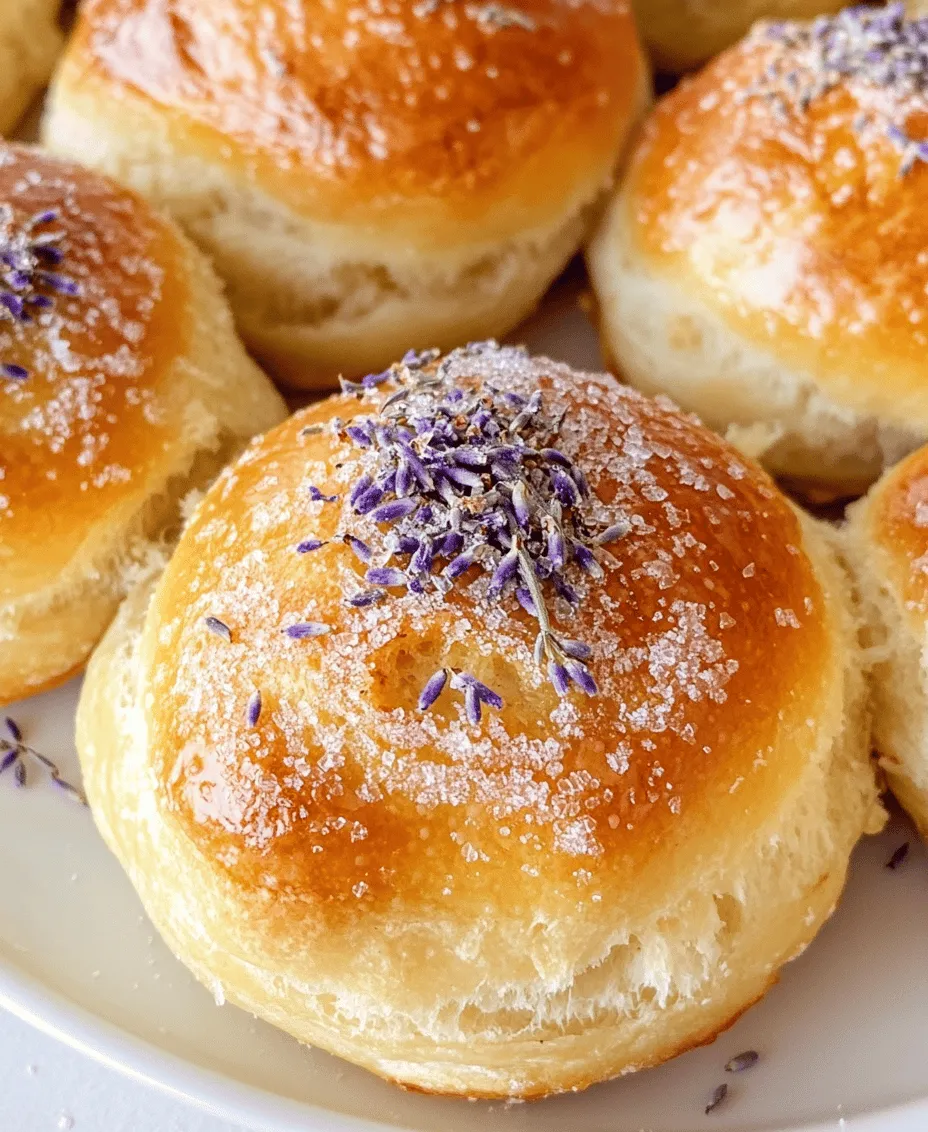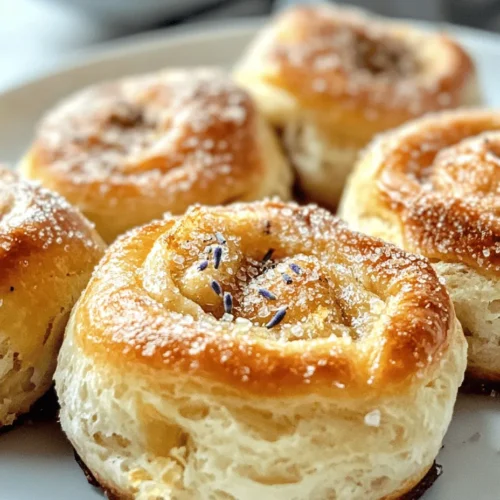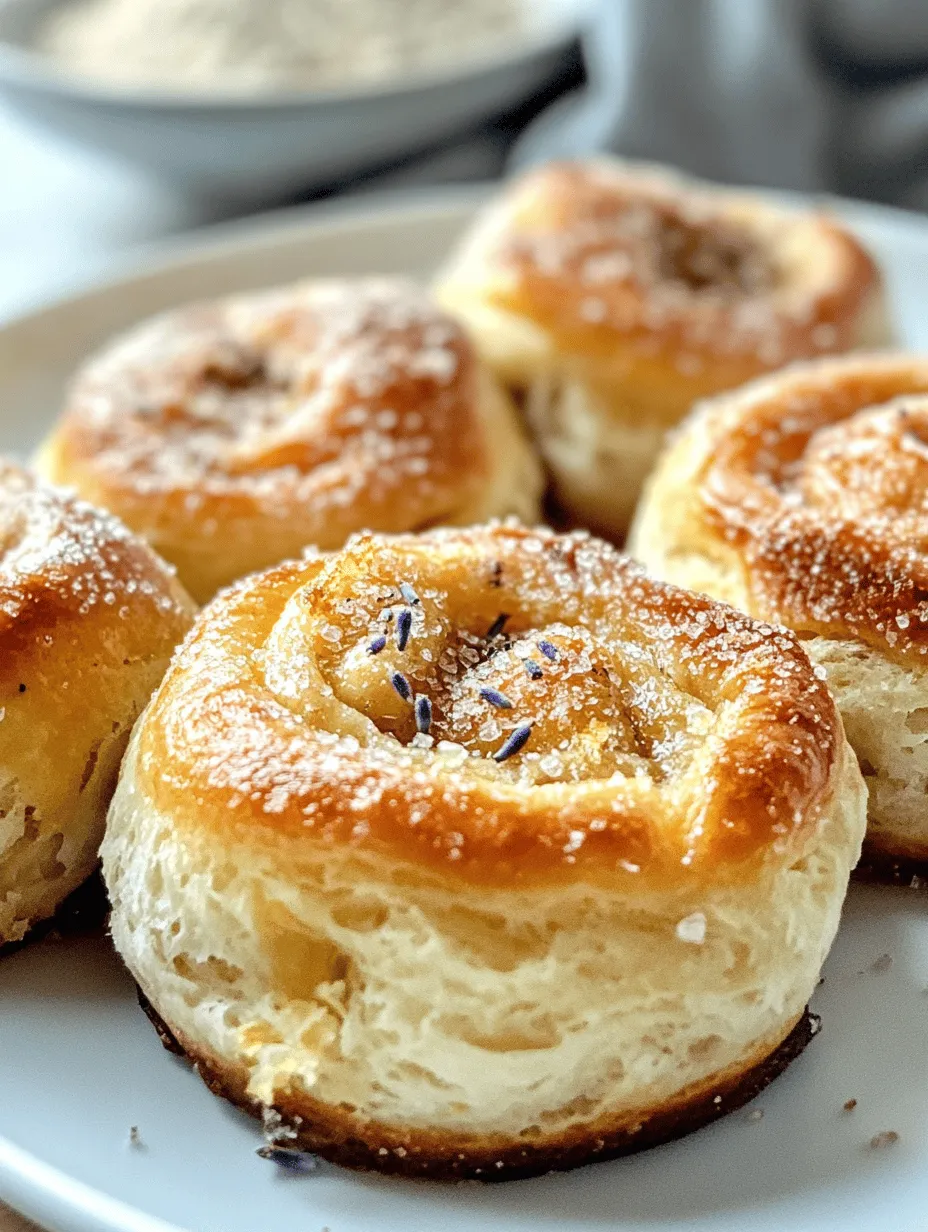Introduction
Imagine the invigorating scent of citrus mingling with the delicate aroma of floral lavender, creating a treat that’s as pleasing to the palate as it is to the senses. The Delightful Lemon Lavender Tea Buns embody this enchanting fusion, offering a refreshing and sophisticated twist on traditional tea buns. These delectable treats are perfect for any occasion, whether you’re hosting a cozy afternoon tea, celebrating a special event, or simply indulging in a moment of self-care with a cup of your favorite brew.
Tea buns have long held a cherished place in culinary traditions across the globe, known for their versatility and ease of preparation. Originating in the United Kingdom, these delightful pastries have evolved through the years, often served alongside tea or as part of festive gatherings. Their simple yet satisfying nature makes them a beloved choice for bakers and tea enthusiasts alike. In this article, we will provide a comprehensive guide that will not only teach you how to create these lemon lavender delights but also expand your baking repertoire with this unique and flavorful recipe.
The Allure of Lemon and Lavender
The harmonious combination of lemon and lavender creates a flavor profile that is both refreshing and aromatic. Lemon, with its bright and zesty flavor, adds a tangy brightness to the buns that complements the sweet, floral notes of lavender beautifully. This pairing not only tantalizes the taste buds but also evokes a sense of calm and relaxation, making these buns an ideal accompaniment to your tea ritual.
Beyond their delightful flavor, both lemon and lavender offer numerous health benefits. Lemon is known for its high vitamin C content, which supports the immune system and promotes healthy digestion. Additionally, the bright citrus aroma can enhance mood and boost energy levels. Lavender, on the other hand, has been historically celebrated for its calming properties. It is often used in aromatherapy to reduce anxiety and stress, and its culinary uses have gained popularity in recent years. Adding dried culinary lavender to your baking not only elevates the flavor but also provides a soothing experience that can enhance overall well-being.
Culturally, lavender has played a significant role in various cuisines, particularly in Mediterranean regions. Its fragrant blossoms have been used in both sweet and savory dishes, adding a unique twist to traditional recipes. As we embrace these flavors in the Delightful Lemon Lavender Tea Buns, we honor this culinary heritage while introducing a modern twist that appeals to contemporary palates.
Ingredients Breakdown
To create these delectable lemon lavender tea buns, you’ll need a selection of high-quality ingredients that come together to create a harmonious blend of flavors and textures. Below is a detailed list of each ingredient, along with an explanation of their roles in the recipe:
All-Purpose Flour
All-purpose flour serves as the foundation of the tea buns. Its balanced protein content provides the right structure and texture, allowing the buns to rise beautifully while remaining tender and light.
Baking Powder
Baking powder acts as the leavening agent, helping the buns achieve their characteristic light and fluffy texture. It releases carbon dioxide gas when mixed with liquid, which causes the dough to expand during baking.
Salt
Salt is a crucial ingredient that enhances the overall flavor of the buns. It balances the sweetness of the sugar while accentuating the floral notes of the lavender and the brightness of the lemon.
Granulated Sugar
Granulated sugar adds sweetness to the buns and contributes to their browning during the baking process. The sugar not only sweetens the dough but also helps create a delightful crust on the exterior.
Dried Culinary Lavender
Dried culinary lavender is the star ingredient that imparts a distinct floral aroma and flavor to the buns. It’s important to use culinary-grade lavender, as some varieties may be treated with chemicals that are not safe for consumption.
Unsalted Butter
Unsalted butter adds richness and flakiness to the buns. Its fat content contributes to a tender crumb, making each bite melt in your mouth. Using unsalted butter allows you to control the overall saltiness of the recipe.
Heavy Cream
Heavy cream provides moisture and tenderness to the dough. It contributes to a rich flavor and helps create a soft texture that is essential for achieving the perfect tea bun.
Egg
The egg serves as a binding agent, helping to hold the ingredients together while adding richness to the dough. It also aids in the leavening process, contributing to the light and airy texture.
Lemon Zest
Fresh lemon zest brightens the flavor profile of the buns, adding a burst of citrusy freshness that complements the floral notes of lavender. The zest contains essential oils that enhance the overall aroma and taste.
Vanilla Extract
Vanilla extract adds depth of flavor to the buns, rounding out the sweetness and contributing to the overall complexity of the taste. It pairs beautifully with both the lemon and lavender, creating a well-balanced treat.
Extra Sugar for Sprinkling
A sprinkle of extra sugar on top of the buns before baking provides a delightful contrast in texture and an additional touch of sweetness. This finishing touch enhances the visual appeal of the buns, making them even more tempting.
Preparation Steps
Now that we have gathered our ingredients, it’s time to delve into the preparation process for our Delightful Lemon Lavender Tea Buns. Follow these detailed steps to ensure a successful baking experience:
Step 1: Preheat the Oven
Before you start mixing your ingredients, preheat your oven to 375°F (190°C). This ensures that the buns will bake evenly and achieve a golden-brown color.
Step 2: Prepare the Baking Sheet
Line a baking sheet with parchment paper or a silicone baking mat. This will prevent the buns from sticking and make for easy cleanup after baking.
Step 3: Combine Dry Ingredients
In a large mixing bowl, sift together the all-purpose flour, baking powder, salt, and granulated sugar. Sifting the dry ingredients not only combines them but also aerates the flour, leading to a lighter texture in the finished buns.
Step 4: Infuse the Lavender
In a small saucepan, melt the unsalted butter over low heat. Once melted, remove it from the heat and add the dried culinary lavender. Allow the lavender to steep in the butter for about 10 minutes, releasing its essential oils and flavor. After steeping, strain the mixture through a fine-mesh sieve to remove the lavender buds, ensuring a smooth butter mixture for your dough.
Step 5: Mix Wet Ingredients
In a separate bowl, whisk together the heavy cream, egg, lemon zest, and vanilla extract. Once combined, add the infused butter to the wet mixture, stirring until smooth.
Step 6: Combine Wet and Dry Ingredients
Pour the wet ingredients into the bowl with the dry ingredients. Gently fold the mixture together using a spatula or wooden spoon until just combined. Be careful not to overmix, as this can lead to dense buns. The dough should be slightly sticky but manageable.
Step 7: Shape the Buns
Turn the dough out onto a lightly floured surface. With floured hands, gently knead the dough a few times to bring it together. Divide the dough into equal portions, shaping each piece into a round bun. Place the buns onto the prepared baking sheet, spacing them a few inches apart to allow for expansion during baking.
Step 8: Sprinkle with Sugar
Before placing the buns in the oven, sprinkle the tops with extra sugar. This will create a delightful, sweet crust that enhances the overall flavor and appearance of the buns.
Step 9: Bake the Buns
Carefully place the baking sheet in the preheated oven. Bake for 15-20 minutes, or until the buns are golden brown and a toothpick inserted into the center comes out clean. Keep an eye on them to ensure they do not overbake, as this can affect their tenderness.
As the buns bake, the kitchen will fill with the irresistible combination of lemon and lavender aromas, promising a delightful treat that will soon be ready to enjoy.
This marks the beginning of your journey to creating Delightful Lemon Lavender Tea Buns. The next steps will guide you through cooling and serving these exquisite pastries, but for now, the anticipation of their deliciousness is already in the air. Stay tuned for the continuation of this recipe, where we’ll explore how to finish and serve these delightful treats in style.

Mixing Dry Ingredients
To achieve the best results for your Delightful Lemon Lavender Tea Buns, begin by mixing the dry ingredients properly. This step is crucial to avoid lumps that can affect the final texture of your buns. Start with a clean mixing bowl and sift together the all-purpose flour, baking powder, salt, and dried culinary lavender. Sifting not only combines these ingredients but also aerates the flour, resulting in lighter buns. Once sifted, use a whisk to further blend the dry ingredients, ensuring that the baking powder is evenly distributed. This method helps prevent any pockets of baking powder from forming, which could lead to uneven rising during baking.
Cutting in Butter
Next, it’s time to cut in the butter. This step is essential for achieving the right texture in your buns. Using cold, unsalted butter, cut it into small cubes and add it to the flour mixture. There are a couple of effective methods for this process. The first is using a pastry cutter, which allows you to blend the butter into the flour until the mixture resembles coarse crumbs. Alternatively, you can use your fingertips to rub the butter into the flour, working quickly to avoid warming the butter. The goal is to incorporate the butter without melting it, as this will create a flaky texture in the finished buns.
Combining Wet and Dry Ingredients
Once the butter is successfully cut into the flour mixture, it’s time to combine the wet and dry ingredients. In a separate bowl, whisk together the milk, egg, lemon zest, and lemon juice. Slowly pour this mixture into the dry ingredients, stirring gently with a spatula or wooden spoon. It is crucial not to overmix at this stage; overmixing can lead to tough buns due to gluten development. Stop mixing as soon as the dough comes together. It’s perfectly fine if there are a few small floury spots remaining, as they will incorporate during the shaping process.
Shaping the Dough
Now that the dough is mixed, it’s time to shape it. Lightly flour your work surface and gently turn the dough out onto it. Using your hands, pat the dough into a rectangle about ¾ inch thick. This thickness is ideal for creating fluffy tea buns. Avoid rolling the dough with a rolling pin, as this can compress it and lead to denser buns. Instead, use a gentle touch to maintain the airiness you’ve created in the mixing phase.
Cutting the Buns
With the dough shaped, you can now cut the buns into your desired shapes. A sharp knife or a biscuit cutter works well for this. For a traditional look, cut the dough into squares or triangles. For a more playful presentation, consider using cookie cutters to create fun shapes like hearts or flowers. Remember to space the buns out evenly on your baking sheet to allow for expansion during baking.
Baking Tips
When it comes to baking the tea buns, achieving the perfect golden-brown color is key. Preheat your oven to 375°F (190°C) and line a baking sheet with parchment paper. Place the cut buns on the prepared sheet, ensuring they are spaced apart. Bake for 15-20 minutes, or until the tops are lightly golden and a toothpick inserted into the center comes out clean. Keep a close eye on the buns during the final minutes of baking, as they can go from perfectly golden to overbaked quickly.
Baking the Tea Buns
Baking time and temperature are crucial to the success of your lemon lavender tea buns. Maintaining the right temperature ensures even cooking and helps achieve that desirable golden color. As a general guideline, aim for 15-20 minutes of baking time. You’ll know the buns are perfectly baked when they are golden brown on top and sound hollow when tapped on the bottom.
After pulling the buns from the oven, allow them to cool on the baking sheet for about 5 minutes before transferring them to a wire rack. This cooling process is essential for the texture and flavor enhancement. It allows steam to escape and helps the buns firm up slightly, making them easier to handle and enhancing their overall flavor.
Serving Suggestions
Now that your lemon lavender tea buns are baked to perfection, it’s time to think about serving. These delightful treats are perfect for a variety of occasions. Consider serving them at afternoon tea alongside a pot of Earl Grey or chamomile tea, where their citrusy and floral notes can shine.
You can also elevate the buns by adding a drizzle of lemon glaze or simply a light dusting of powdered sugar. Honey or clotted cream can serve as delightful accompaniments, balancing the bright lemon flavor. For brunch, consider pairing them with fresh fruit and yogurt for a light and refreshing menu.
Storage and Shelf Life
To keep your leftover tea buns fresh, store them in an airtight container at room temperature for up to 3 days. If you want to extend their shelf life, consider freezing them. Wrap each bun in plastic wrap and place them in a freezer-safe container. They can be frozen for up to 2 months. To enjoy, simply thaw at room temperature or reheat in the oven for a few minutes to restore their delightful texture.
Nutritional Information
Understanding the nutritional aspects of your lemon lavender tea buns can help you enjoy them in moderation. Each bun is approximately 150 calories, depending on the specific ingredients used. They are a source of carbohydrates and provide a small amount of protein and fats due to the butter and milk. For health-conscious readers, consider serving smaller portions or enjoying them as an occasional treat rather than a daily indulgence.
Conclusion
In summary, the unique flavor and texture of delightfully baked lemon lavender tea buns make them a cherished recipe in any baker’s repertoire. The bright lemon zest paired with the subtle floral notes of lavender creates a harmonious blend that is perfect for any tea-time gathering.
Don’t hesitate to experiment with the recipe, perhaps by adding a touch of your favorite spices or toppings. Each batch can be a new adventure in flavor. Baking is not just about the final product; it’s also about the joy it brings to the baker and those who share in the enjoyment of these sweet treats. So gather your ingredients, unleash your creativity, and relish the satisfaction of creating something delicious from scratch.



